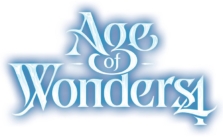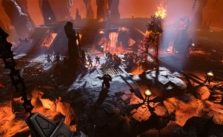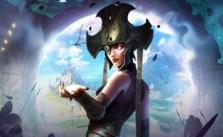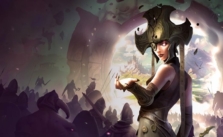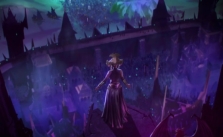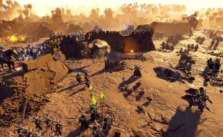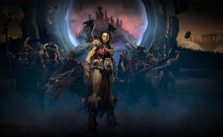Age of Wonders 4: Faction Creation and Customization Guide
The first step in creating your faction is selecting a culture. Your culture will determine your affinities, unique buildings, and access to specific game mechanics. There are six primary cultures in Age of Wonders 4.
Race Cultures
Dark cultures have an affinity for Shadow and excel in knowledge production in governed cities. They negate penalties to income derived from instability and have unique structures that provide further knowledge production and income from prisons and crypts. Dark cultures take advantage of negative status effects on enemy units in battle, using Call the Weak to deal extra damage and replenishing hit points when killing a unit.
Mystic cultures have an Astral affinity and are skilled in mana production in governed cities. They have structures providing mana income, and their units with Attunement Star Blades receive a bonus to their damage of either fire, lightning, or frost type. This bonus can be stacked up to three times, lasting for three turns as long as the spell is cast. Mystic cultures are the only ones who can see Astral Echoes, pick-ups that grant knowledge and mana.
Feudal Cultures, with affinities for Order and Nature, excel in gold and food production within their governed cities. Furthermore, they possess enhanced food production abilities, and their units gain the “Stand Together” trait, which increases damage output when positioned next to a friendly unit. Unique to Feudal Cultures, five heroes can be granted the title of Feudal Lord, providing buffs to the cities they govern and the armies they lead.
Barbarian Cultures have affinities for Chaos and Nature, bolstering the production of draft and food in governed cities. They have additional food and draft production capabilities, and their melee units have the Primal Strike ability, causing +8 light damage on their first melee attack that hits per battle. Their “Ritual of Alacrity” helps heal units, restore their movement points, and remove exhaustion from forced marches.
Industrious Cultures, leaning towards Materium affinity. They benefit from a greater number of structures that generate production income, and their units can accumulate Bolster Defense up to five times in a turn. Moreover, Industrious Cultures gain access to scout prospecting, which enables them to use the prospect action on provinces to acquire production, gold, or hero items.
High Cultures exhibit an affinity for Order, resulting in increased gold production in their governed cities, while their buildings strengthen stability and knowledge income. Their units have latent abilities that can be activated through spells or actions, adding +4 Spirit damage output to their base attacks. High Cultures also start with a modified alignment, which influences the relationships they can develop.
Picking Society Traits
After selecting your culture, you’ll choose two society traits from a set of 18. These traits will add to your affinities, and some will impact your alignment. Society traits include options such as Chosen Uniters, Devotees of Good, Imperialists, Prolific Swarmers, Ritual Cannibals, Ruthless Raiders, Ancient Wise Ones, Gifted Casters, Mana Channelers, Adept Settlers, Experienced Seafarers, Fabled Hunters, Great Builders, Ruinsmiths, Wonder Architects, Devious Watchers, Powerful Evokers, and Scions of Evil.
Each society trait provides unique bonuses and abilities, which will significantly affect your gameplay. For example, Chosen Uniters earn more from vassals and have additional Whispering Stones to improve relations with free cities. Meanwhile, Ritual Cannibals can consume the corpses of fallen foes and friends in battle to recover HP. Carefully consider your playstyle and goals when selecting your society traits.
The Tomes of Magic
Next, you will pick one from 12 Tier 1 Tomes of Magic. You’ll start your campaign with two randomly picked spells from the chosen tome, with the option to research other spells using your knowledge. Some of the available Tomes of Magic include:
- Tome of Enchantment: Enhances troops with bonuses to range, resistances against status effects, and their ability to break through enemy defenses and fortifications. This tome also includes a spell to increase city productivity at the cost of stability.
- Tome of Beasts: Focuses on animal units and cavalry, with a special penchant for flanking through the use of spells and leader traits.
- Tome of Roots: Concentrates on healing and summons, with particular attention to food production and inflicting blight damage and poisoned effects.
- Tome of Zeal: Involves pairing Condemned and Zeal statuses with spells or units that hurt or bolster them accordingly.
- Tome of Faith: Provides knowledge and healing-related opportunities with the potential to reduce unit upkeep costs.
- Tome of Souls: Enables the collection of Souls and the raising of ruined cities and dead heroes alike, while also giving access to skeleton units and focusing on collecting Souls as a resource to produce Undead units and cast certain spells.
- Tome of Cryomancy: Revolves around Frost damage at the cost of physical damage output and freezing enemies to help immobilize them.
- Tome of Evocation: All about mana generation and lightning attacks, decreasing enemy resistance to lightning damage and applying electrified damage over time effects.
- Tome of Warding: Focuses on improving the survivability of friendly units by adding resistances, making them entirely invulnerable or enabling them to potentially stun an enemy that attacks them.
- Tome of The Horde: Concentrates on increased damage against enemies, the use of fire, and a unique Hound Master unit that can summon hounds.
- Tome of Pyromancy: Emphasizes fire damage, summoning and recruiting units that cause it while using the burning status effects for damage over time and added efficiencies.
- Tome of Rock: Focuses on summons, improved defenses of different types, physical damage spells, and the use of rocky terrain to the advantage of a transformed minor race.
Building the Faction Leader
Once you have selected your tome, it’s time to build your faction leader. You have two options for your leader: the Champion of the People or the Outsider, a Wizard King.
Champion of the People: Boosts gold income and stability in cities, improves unit experience gain, and enhances relations with free cities. The champion must be of the same race as the population, as they rise from the people to become their leader.
Outsider (Wizard King): Offers improved mana income and spellcasting capabilities. The Wizard King can have a different form from the rest of the faction.
Each leader type has varying starting equipment options, with the Wizard King having consistent access to specific options, while the Champion’s options are modified by prior decisions made during faction creation, allowing for a greater variety of equipment, mounts, and abilities.
Customize your leader’s appearance, interactions, and banners, all influenced by your prior decisions. Finally, choose a title based on your faction’s makeup, names for your leader and faction, and a short description built from your choices to add some flavor.
Age of Wonders 4 Ultimate Beginner’s Guide: Tips for New Players



